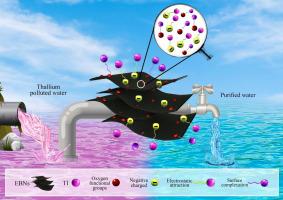Chemical Engineering Journal ( IF 13.3 ) Pub Date : 2022-01-20 , DOI: 10.1016/j.cej.2022.134842 Muhammad Haris 1 , Muhammad Usman 2 , Fang Su 1 , Wang Lei 1 , Atif Saleem 3 , Yasir Hamid 4 , JunKang Guo 1 , Yongtao Li 1, 5

|
Tailoring the pathways to synthesize efficient biochars for pollutant adsorption has received extensive attention. Here, we synthesized highly efficient exfoliated biochar having thin layered nanosheets in its structure from agricultural wastes (wheat straw) by an innovative method involving biomass pre-treatment, nitrogen pyrolysis, and a flash heat exfoliation for thallium(I) removal from contaminated waters. Exfoliated biochar with nanosheets in its structure (EBNs) exhibited an open porous structure with a BET surface area 421.24 m2 g−1 and pore size 3.98 nm, much higher than the 3.81 m2 g−1 and 2.05 nm, respectively, of pristine wheat-straw biochar (PB). Using these materials for the adsorption of T1(I) revealed that the EBNs had a maximum adsorption capacity of 382.38 mg g−1 at pH 7.0, over 9 times higher than the PB. The adsorption kinetics and isotherm data were better fitted by pseudo-second order and Langmuir models. Moreover, EBNs retained its selective adsorption capacity for T1(I) in the presence of competing ions (Ca2+, Mg2+, K+, Cu2+, Zn2+) and organic materials (humic acid, fulvic acid). Also, high regeneration ability (>93%) of EBNs was noted for five consecutive adsorption-desorption cycles. The efficiency of EBNs was also tested in river water (sampled from Bahe river, Xi’an, West China) spiked with T1(I) where it removed ∼90% of T1(I). These findings highlight the potential of EBNs for practical water treatment applications by developing the biochar nanosheets from agricultural wastes and provide insights into a new strategy to develop cost-effective carbon-based nanomaterials for wastewater treatment.











































 京公网安备 11010802027423号
京公网安备 11010802027423号